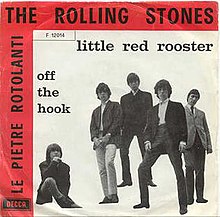Little Red Rooster
| "The Red Rooster" | |
|---|---|
 |
|
| Single by Howlin' Wolf | |
| B-side | "Shake for Me" |
| Released | October 1961 |
| Format | 7-inch 45 rpm record |
| Recorded | Chicago, June 1961 |
| Genre | Chicago blues |
| Length | 2:25 |
| Label | Chess (no. 1804) |
| Writer(s) | Willie Dixon |
| Producer(s) | Leonard Chess, Phil Chess, Willie Dixon |
| ISWC | T-070.241.754-6 |
| "Little Red Rooster" | |
|---|---|

Italian single picture sleeve
|
|
| Single by the Rolling Stones | |
| B-side | "Off the Hook" |
| Released | November 13, 1964 |
| Format | 7-inch 45 rpm record |
| Recorded |
|
| Studio |
|
| Genre | Blues |
| Length | 3:05 |
| Label | Decca (no. F 12014) |
| Writer(s) | Willie Dixon |
| Producer(s) | Andrew Loog Oldham |
"Little Red Rooster" (or "The Red Rooster" as it was first titled) is a blues standard credited to arranger and songwriter Willie Dixon. The song was first recorded in 1961 by American blues musician Howlin' Wolf in the Chicago blues style. His vocal and slide guitar playing are key elements of the song. It is rooted in the Delta blues tradition and the theme is derived from folklore. Musical antecedents to "Little Red Rooster" appear in earlier songs by blues artists Charlie Patton and Memphis Minnie.
A variety of musicians have interpreted and recorded "Little Red Rooster". Some add new words and instrumentation to mimic the sounds of animals mentioned in the lyrics. American soul music singer Sam Cooke adapted the song using a more uptempo approach and it became a successful single on both the US rhythm and blues and pop record charts in 1963. Concurrently, Dixon and Howlin' Wolf toured the UK with the American Folk Blues Festival and helped popularize Chicago blues with local rock musicians overseas.
The Rolling Stones were among the first British rock groups to record modern electric blues songs. In 1964, they recorded "Little Red Rooster" with original member Brian Jones, a key player in the recording. Their rendition, which remains closer to the original arrangement than Cooke's, became a number one record in the UK and continues to be the only blues song to reach the top of the British chart. The Stones frequently performed it on television and in concert and released several live recordings of the song. "Little Red Rooster" continues to be performed and recorded, making it one of Willie Dixon's best-known compositions.
Willie Dixon's "The Red Rooster"/"Little Red Rooster" uses elements from several earlier blues songs. The theme reflects early twentieth century folk beliefs in the American South that a rooster contributes to peace in the barnyard. The image of the rooster appears in several blues songs from the 1920s and 1930s, with two particular songs identified as precursors. Influential Delta blues musician Charlie Patton's 1929 "Banty Rooster Blues" contains the verses "What you want with a rooster, he won't crow 'fore day" and "I know my dog anywhere I hear him bark", which are analogous to Dixon's "I have a little red rooster, too lazy to crow 'fore day" and "Oh the dogs begin to bark". Some of the lyrics to Memphis Minnie's 1936 acoustic combo blues "If You See My Rooster (Please Run Him Home)" are also similar. For example, she sings "If you see my rooster, please run 'im on back home", while Dixon uses "If you see my little red rooster, please drive 'im home". Additionally, similar melody lines are found in both songs. For her recording, Memphis Minnie does a full-throated imitation of a rooster's crow. Mimicking animal sounds later became a feature of several recordings of "Little Red Rooster".
...
Wikipedia
